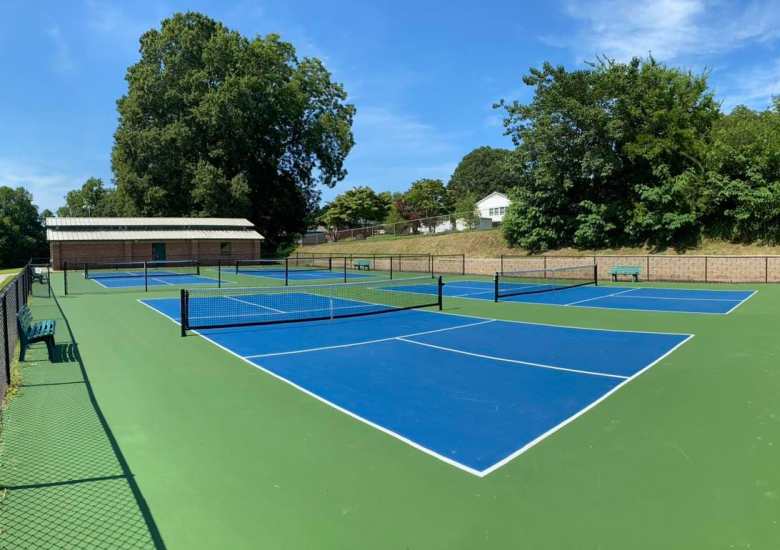Common Mistakes to Avoid in Your Pickleball Court Construction Process
Common Mistakes to Avoid in Your Pickleball Court Construction Process
Blog Article
Navigating Regulations for Pickleball Court Construction in Your Location
Constructing a pickleball court in your location calls for a nuanced understanding of numerous local guidelines, including zoning legislations, building authorizations, and security criteria. Each community enforces specific standards that can substantially influence the usefulness of your job. Engaging with neighborhood authorities and the area is essential for making sure conformity and cultivating assistance. Nonetheless, navigating this governing landscape can be lengthy and intricate. What are the vital actions you should take into consideration to avoid potential mistakes and make certain a smooth building and construction process?
Recognizing Neighborhood Zoning Regulations
When thinking about the building and construction of a pickleball court, recognizing neighborhood zoning laws is vital to ensuring conformity and preventing possible legal concerns. Zoning guidelines determine how land can be utilized and usually include specs associated to leisure facilities. These legislations can differ dramatically by municipality, affecting elements such as court placement, size, sound, and illumination levels.
Prior to starting building, it is vital to speak with the local zoning board or preparation division to identify the certain policies that use to your residential property. Particular zones may restrict leisure activities, while others may need certain authorizations or adherence to specific guidelines. It is also vital to take into consideration obstacles, which figure out exactly how far frameworks need to be from building lines or various other buildings.
In addition, personal developments, such as homeowner organizations (HOAs), may enforce their very own rules regarding the building and use pickleball courts. Recognizing these laws can stop pricey modifications or lawsuits down the line. Involving with neighborhood stakeholders and area members can give useful insights and foster assistance for your project, making certain that it lines up with the area's expectations and demands.
Obtaining Necessary Structure Permits
Exactly how does one browse the complexities of getting required structure permits for a pickleball court? The process starts with understanding regional regulations and demands stated by community authorities. Commonly, you will require to send a comprehensive website strategy that describes the recommended court measurements, materials, and design. This strategy needs to adhere to zoning legislations and any kind of specific policies referring to entertainment facilities.

As soon as permits are acquired, it is crucial to stick to any type of examination schedules and demands throughout the building and construction phase. Preserving interaction with neighborhood authorities will certainly help with a smoother approval process and aid stay clear of potential problems. By completely preparing and recognizing the allowing landscape, you can successfully navigate the complexities associated with building a pickleball court while staying certified with all neighborhood laws.

Assessing Environmental Impact
A thorough evaluation of ecological effect is crucial when preparing the construction of a pickleball court. This evaluation assists recognize potential impacts on neighborhood ecosystems, water resources, and area aesthetics. Key variables to think about consist of site choice-- making sure that the court is not built on ecologically sensitive land, such as marshes or environments for endangered species
Soil security and water drainage patterns need to be analyzed to stop disintegration and water merging, which can negatively affect surrounding greenery and wildlife. Furthermore, the option of products is essential; choosing sustainable and environment-friendly alternatives decreases ecological injury.
The implementation of effective stormwater management practices is another vital aspect, as it helps mitigate runoff and sedimentation. Involving with local environmental companies can offer important insights into regulations and ideal techniques details to your location.
Finally, neighborhood input can be useful in comprehending any type of local ecological problems and cultivating support for the project. By conducting a thorough ecological effect evaluation, stakeholders can guarantee that pickleball court construction straightens with lasting practices and adds favorably to the neighborhood's ecological wellness.
Adhering To Security Standards
Ensuring conformity with security criteria is important for the successful construction and procedure of a pickleball court. Abiding by established safety and security policies minimizes the danger of injuries and crashes, guaranteeing a secure setting for players.
Trick safety criteria include correct court dimensions, surface area materials, and illumination needs. The court should fulfill the official measurements of 20 feet wide by 44 feet long for increases play, with appropriate buffer areas to avoid injuries from wayward balls. Pickleball court construction. The surface needs to be constructed from non-slip products to boost traction and minimize the chance of falls
Furthermore, lighting should be ample for evening play, giving uniform illumination to prevent darkness that can hinder exposure. Regional structure codes may likewise determine details requirements for fence and internet height to guarantee gamer safety and security and prevent unauthorized accessibility to the court area.
Routine examinations and maintenance are vital to promote these criteria over time. By prioritizing security compliance, court proprietors not only protect gamers yet additionally promote a positive why not check here reputation within the community. This commitment to safety can motivate higher involvement and pleasure of the sport, eventually adding to its growth and sustainability.

Engaging the Area in Planning
Neighborhood participation in the drawing board of pickleball court building can significantly enhance the job's general success. Involving neighborhood residents and stakeholders promotes a sense of possession and urges joint decision-making, which can lead to broader support for the effort.
To successfully entail the area, coordinators must initiate public conferences or workshops, supplying a platform for residents to articulate their viewpoints and preferences regarding location, design, and facilities. Surveys and comments types can likewise be used to gather insights from a larger audience, ensuring that diverse viewpoints are taken into consideration.
In addition, creating an area board of advisers can assist in continuous discussions and address issues throughout the planning process. This board can useful source include reps from numerous demographics, such as regional institutions, recreational organizations, and neighborhood organizations, consequently magnifying neighborhood representation.
Effective interaction is vital; updates regarding the project ought to be frequently shared by means of newsletters, social media, or neighborhood publications. By prioritizing area engagement, organizers can grow enthusiasm, mitigate possible opposition, and develop a pickleball facility that truly reverberates with local worths and requirements. This collaborative technique not only enhances the job however additionally reinforces area ties.
Final Thought
In final thought, navigating the complexities of pickleball court building necessitates a comprehensive understanding of regional laws, including zoning regulations, structure permits, and security requirements. By sticking to these guidelines and fostering collaboration, effective execution of pickleball courts can be accomplished, promoting leisure opportunities and area health.
Building a pickleball court in your area calls for a nuanced understanding of numerous local policies, consisting of zoning regulations, structure authorizations, and safety criteria.When thinking about the building and construction of a pickleball court, recognizing regional zoning legislations is important to making sure compliance and avoiding possible lawful concerns. By thoroughly preparing and recognizing the permitting landscape, you can successfully navigate the intricacies included in constructing a pickleball court while remaining certified with all regional policies.
In final thought, browsing article source the complexities of pickleball court building and construction requires an extensive understanding of neighborhood laws, including zoning regulations, structure licenses, and safety criteria. By adhering to these standards and promoting collaboration, successful application of pickleball courts can be achieved, advertising entertainment opportunities and community wellness.
Report this page